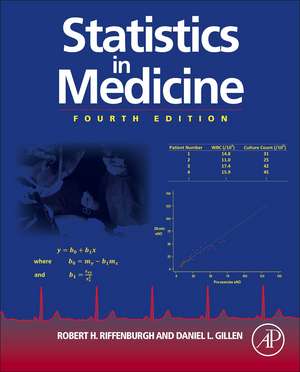Statistics in Medicine
Autor Robert H. Riffenburgh, Daniel L. Gillenen Limba Engleză Hardback – 24 iul 2020
This book does not require background knowledge of statistics or mathematics beyond high school algebra and provides abundant clinical examples and exercises to reinforce concepts. It is a valuable source for biomedical researchers, healthcare providers and anyone who conducts research or quality improvement projects.
- Expands and revises important topics, such as basic concepts behind descriptive statistics and testing, descriptive statistics in three dimensions, the relationship between statistical testing and confidence intervals, and more
- Presents an easy-to-follow format with medical examples, step-by-step methods and check-yourself exercises
- Explains statistics for users with little statistical and mathematical background
- Encompasses all research development stages, from conceiving a study, planning it in detail, carrying out the methods, putting obtained data in analyzable form, analyzing and interpreting the results, and publishing the study
Preț: 487.40 lei
Preț vechi: 617.22 lei
-21% Nou
93.26€ • 97.64$ • 77.17£
Carte disponibilă
Livrare economică 10-24 martie
Specificații
ISBN-10: 0128153288
Pagini: 822
Dimensiuni: 191 x 235 x 36 mm
Greutate: 1.38 kg
Ediția:4
Editura: ELSEVIER SCIENCE
Public țintă
biostatisticians, graduate students, biomedical and medical researchers, healthcare professionalsCuprins
1. Planning Studies: From Design to Publication 2. Planning Analysis: Addressing Your Scientific Objective 3. Probability and Relative Frequency 4. Distributions 5. Descriptive Statistics 6. Finding Probabilities 7. Hypothesis Testing: Concept and Practice 8. Confidence Intervals 9. Tests on Categorical Data 10. Risks, Odds, and ROC Curves 11. Tests of Location with Continuous Outcomes 12. Equivalence Testing 13. Tests on Variability and Distributions 14. Measuring Association and Agreement 15. Linear Regression and Correlation 16. Multiple Linear and Curvilinear Regression 17. Logistic Regression for Binary Outcomes 18. Regression Models for Count Outcomes 19. Analysis of Censored Time-To-Event Data 20. Analysis of Repeated Continuous Measures of Time 21. Sample Size Estimation 22. Clinical Trials and Group Sequential Analyses 23. Epidemiology and Alternative Sampling Designs 24. Meta Analyses 25. Bayesian Statistics 26. Questionnaires and Surveys 27. Techniques to Aid Analysis 28. Methods You Might Meet, But Not Every Day
Descriere
Statistics in Medicine, Fourth Edition, helps medical and biomedical investigators design and answer questions about analyzing and interpreting data and predicting the sample size required to achieve useful results. It makes medical statistics easy for the non-biostatistician by outlining common methods used in 90% of medical research. The text covers how to plan studies from conception to publication, what to do with data, and follows with step-by-step instructions for biostatistical methods from the simplest levels, to more sophisticated methods now used in medical articles. Examples from almost every medical specialty, and from dentistry, nursing, pharmacy and health care management are provided.
This book does not require background knowledge of statistics or mathematics beyond high school algebra and provides abundant clinical examples and exercises to reinforce concepts. It is a valuable source for biomedical researchers, healthcare providers and anyone who conducts research or quality improvement projects.
- Expands and revises important topics, such as basic concepts behind descriptive statistics and testing, descriptive statistics in three dimensions, the relationship between statistical testing and confidence intervals, and more
- Presents an easy-to-follow format with medical examples, step-by-step methods and check-yourself exercises
- Explains statistics for users with little statistical and mathematical background
- Encompasses all research development stages, from conceiving a study, planning it in detail, carrying out the methods, putting obtained data in analyzable form, analyzing and interpreting the results, and publishing the study

